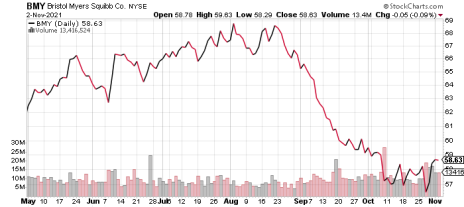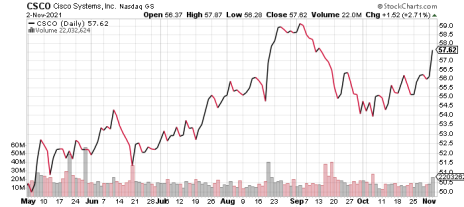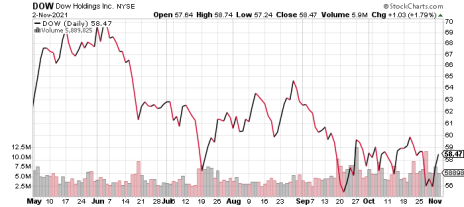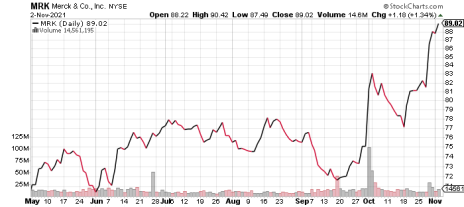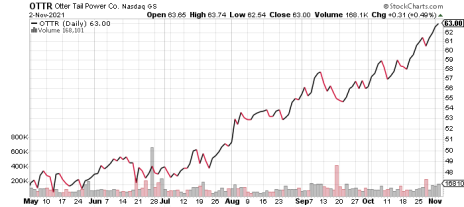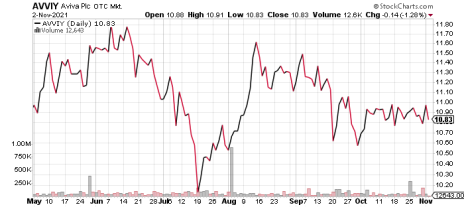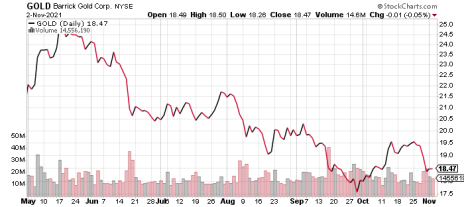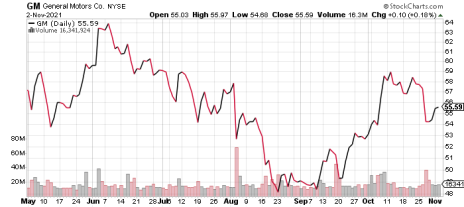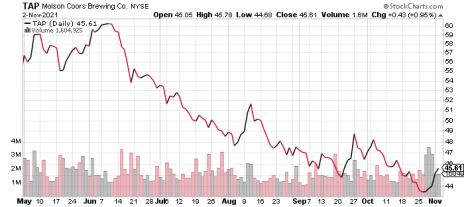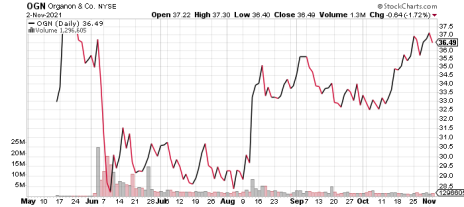Thank you for subscribing to the Cabot Undervalued Stocks Advisor. We hope you enjoy reading the November 2021 issue.
Rivian Automotive’s (RIVN) initial public offering, which arrives next week at a likely $60 billion valuation, has us thinking more deeply about General Motors (GM). Investors are assigning little value to its EV and other advanced technologies, which strikes us as incompatible with the valuations of Tesla, Rivian and other EV start-ups. But, perhaps this is right, due to the enormous capital spending that GM has committed to. These vast cash outflows may eliminate the present value of the EVs. We share some of our thinking on this.
Market Overview
Carmakers, Expectations and General Motors
Electric truck maker Rivian Automotive (RIVN) is close to launching its IPO. Valuation talk is around $60 billion, which would make it the #7 largest light vehicle producer by market cap. It would be well-behind the super-majors including Tesla ($1.1 trillion), Toyota ($290 billion) and Volkswagen ($142 billion), yet it would be in the same neighborhood as BMW, General Motors, Ford, Stellantis (formerly known as Fiat Chrysler) and Honda. If investors rally behind Rivian’s shares, the company could readily surge to the #4 spot on the leader board. For a company with zero revenues and a $1 billion loss for the past half year, with promises of larger losses ahead, this is clearly impressive.
We’re convinced that electric vehicles will eventually rule the road. A hundred years from now, the average citizen will wonder aloud when they think about how oil was used in the past... “you mean they actually burned that stuff!?”
Yet, that future is not here yet, and we doubt that the pace of adoption will be anything like the optimists anticipate. In the U.S., about 3% of vehicles sold last year were electric vehicles, and these were subsidized by government tax credits and other benefits. In Europe, EV sales currently have a much higher market share, but government subsidies are substantially higher, particularly in France and Germany, so the demand is artificially high. Subsidies of this scale aren’t likely to be coming to the United States, and we wonder if European governments will be able to sustain their current spending on subsidies, much less increase it should even more buyers opt for EVs.
We estimate the collective market value of all car markers globally is about $2.2 trillion. In the past four years, this total value has more than doubled, mostly due to the emergence of Tesla, whose market value was only about $65 billion in late 2017, although gains in shares of other makers have helped.
Where the rubber meets the road to us as investors is in the collective valuation of car companies. Worldwide annual vehicle sales, now running at about 80 million units a year, may increase at a 2% pace at best, to perhaps 94 million by 2030. The 2030 profit pool probably won’t be much larger than it is today, due to intense competition. We don’t have any reasonable understanding, nor does anyone, of the profitability, in 2030, of EVs relative to gas-powered vehicles. And, the capital spending to develop, manufacture and improve EVs and other advanced technologies will be enormous, as previewed by GM’s $35 billion commitment over the next five years.
For GM specifically, our concern is that its profits may not be much higher in 2030 than they are today. If the company wasn’t spending most of its cash flow on EV development, we’d be completely fine with this situation, as the cash that would accumulate would be enormous.
Investors are assigning little value to GM’s new technologies. But, maybe that is correct. Perhaps EVs and other advanced technologies have little present value because the spending is so high and the outcome is so uncertain.
On the surface, we find the implied zero-value of GM’s new technologies to be incompatible with the valuations of Tesla, Rivian and other EV start-ups. But, perhaps investors are currently bidding up auto-tech because the upside potential is huge (while ignoring the possibility of a 100% loss), but GM shares don’t offer this optionality.
As we think about these issues, we are keeping our Buy rating on GM shares but thinking more deeply about the company’s distant future.
Share prices in the table reflect Tuesday (November 2) closing prices. Please note that prices in the discussion below are based on mid-day November 2 prices.
We recently launched a new Earnings and Valuation table. This table will make it easier to see the trends in earnings estimates, and the P/E valuations, for all of the recommended companies. We welcome your feedback and suggestions for further improvements.
Note to new subscribers: You can find additional color on past earnings reports and other news on recommended companies in prior editions and weekly updates of the Cabot Undervalued Stocks Advisor on the Cabot website.
Send questions and comments to Bruce@CabotWealth.com.
Today’s Portfolio Changes
None.
Portfolio changes during the past month
Otter Tail Corporation (OTTR) – Moving from Hold to Sell.
Upcoming earnings releases
November 4: Barrick Gold (GOLD)
November 10: Arcos Dorados (ARCO)
November 11: Aviva plc (AVVIY)
November 11: Organon (OGN)
November 17: Cisco (CSCO)
Growth & Income Portfolio
Growth & Income
Portfolio
Growth & Income Portfolio stocks are generally higher-quality, larger-cap companies that have fallen out of favor. They usually have some combination of attractive earnings growth and an above-average dividend yield. Risk levels tend to be relatively moderate, with reasonable debt levels and modest share valuations.
| Growth/Income Portfolio | |||||||
| Stock (Symbol) | Date Added | Price Added | 11/2/21 | Capital Gain/Loss | Current Dividend Yield | Price Target | Rating |
| Bristol-Myers Squibb (BMY) | 04-01-20 | 54.82 | 58.63 | 7.0% | 3.3% | 78.00 | Buy |
| Cisco Systems (CSCO) | 11-18-20 | 41.32 | 57.62 | 39.4% | 2.5% | 60.00 | Buy |
| Coca-Cola (KO) | 11-11-20 | 53.58 | 56.10 | 4.7% | 2.9% | 64.00 | Buy |
| Dow Inc (DOW) * | 04-01-19 | 53.50 | 58.47 | 9.3% | 4.8% | 78.00 | Buy |
| Merck (MRK) | 12-9-20 | 83.47 | 89.02 | 6.6% | 2.9% | 99.00 | Buy |
| Otter Tail Corporaton (OTTR) | 5-25-21 | 47.10 | 57.75 | 22.6% | 2.7% | 57.00 | Sell |
| Growth/Income Portfolio | |||||||||
| Current price | Current 2022 EPS Estimate | Current 2023 EPS Estimate | Prior 2022 EPS Estimate | Prior 2023 EPS Estimate | Change in 2022 Estimate | Change in 2023 Estimate | P/E 2022 | P/E 2023 | |
| BMY | 59.48 | 7.81 | 8.12 | 7.92 | 8.30 | -1.4% | -2.2% | 7.6 | 7.3 |
| CSCO | 57.27 | 3.43 | 3.69 | 3.43 | 3.68 | 0.0% | 0.3% | 16.7 | 15.5 |
| KO | 56.29 | 2.43 | 2.59 | 2.42 | 2.59 | 0.4% | 0.0% | 23.2 | 21.7 |
| DOW | 58.02 | 6.23 | 6.09 | 6.18 | 6.00 | 0.8% | 1.5% | 9.3 | 9.5 |
| MRK | 90.24 | 7.21 | 7.21 | 6.86 | 7.07 | 5.1% | 2.0% | 12.5 | 12.5 |
Revenues for the company’s key three products, which produce about 65% of total revenues, grew at rates between 7% and 15% compared to a year ago. Sales from its “New product portfolio” of up-and-coming treatments of $344 million (about 3% of total sales) grew 53% from the second quarter, suggesting strong opportunities ahead. Overall, we remain confident in Bristol’s revenue outlook. The company will host an Analysts Day on November 16 to provide more color on its pipeline and overall outlook.Bristol-Myers reported good third-quarter results, with revenues increasing 10% and meeting the consensus estimate. Earnings of $2.00/share rose 23% and exceeded the consensus estimate by about 2%. Management raised their full-year earnings guidance fractionally.
Bristol Myers Squibb Company (BMY) shares sell at a low valuation due to worries over patent expirations for Revlimid (starting in 2022) and Opdivo and Eliquis (starting in 2026). However, the company is working to replace the eventual revenue losses by developing its robust product pipeline while also acquiring new treatments (notably with its acquisitions of Celgene and MyoKardia), and by signing agreements with generics competitors to forestall their competitive entry. The likely worst-case scenario is flat revenues over the next 3-5 years. Bristol should continue to generate vast free cash flow, has a solid, investment-grade balance sheet, and trades at a sizeable discount to its peers.
The adjusted gross margin and adjusted operating margin expanded despite higher research and development spending. The market focuses less on these metrics and instead focuses on revenues. Bristol generated strong free cash flow of about $5 billion, reduced net debt by $3.1 billion, repurchased $500 million in stock and paid about $1 billion in dividends.
BMY shares were weak on the news as investors were apparently disappointed in management’s comments (or lack thereof) on several upcoming clinical trials.
Bristol-Myers was featured in the Cabot Stock of the Week this past Monday.
BMY shares rose 2% in the past week and have about 31% upside to our 78 price target. Valuation remains remarkably low at 7.6x estimated 2022 earnings, compared to 12x or better for its major peer companies. The stock’s 6.7x EV/EBITDA multiple is similarly cheap, compared to 9-10x or better for peers.
The stock has modestly perked up, partly due to some brokerage support and to the remarkably low valuation matched with growing revenues, sturdy cash flow and a fortress balance sheet.
Either we are completely wrong about the company’s fundamental strength, or the market must eventually recognize Bristol’s earnings stability and power. We believe the earning power, low valuation and 3.3% dividend yield that is well-covered by enormous free cash flow make a compelling story. BUY
Cisco Systems (CSCO) is facing revenue pressure as customers migrate to the cloud and thus need less of Cisco’s equipment and one-stop-shop services. Cisco’s prospects are starting to improve under a relatively new CEO, who is shifting Cisco toward a software and subscription model and is rolling out new products, helped by its strong reputation and entrenched position within its customers’ infrastructure. The company is highly profitable, generates vast cash flow (which it returns to shareholders through dividends and buybacks) and has a very strong balance sheet.
There was no significant company-specific news in the past week.
CSCO shares rose 3% in the past week and have about 5% upside to our 60 price target. The shares remain attractively valued and offer a 2.6% dividend yield. We continue to like Cisco. BUY
Coca-Cola (KO) is best-known for its iconic soft drinks yet nearly 40% of its revenues come from non-soda beverages across the non-alcoholic spectrum. Its global distribution system reaches nearly every human on the planet. Coca-Cola’s longer-term picture looks bright, but the shares remain undervalued due to concerns over the pandemic, the secular trend away from sugary sodas, and a tax dispute which could cost as much as $12 billion (likely worst-case scenario). The relatively new CEO James Quincey (2017) is reinvigorating the company by narrowing its over-sized brand portfolio, boosting its innovation and improving its efficiency, as well as improving its health and environmental image. Coca-Cola’s balance sheet is sturdy, and its growth investing, debt service and dividend are well-covered by free cash flow.
Coca-Cola reported an encouraging quarter, with earnings of $0.65/share increasing by 18% from a year ago and beating the consensus estimate of $0.58/share by about 12%. Revenues of $10.0 billion rose 16% from a year ago and were about 3% above the consensus estimate. Free cash flow was strong and now totals $8.5 billion for the year.
More economies are recovering from the pandemic, helping revenues growth, while higher marketing spending fractionally trimmed operating margins. The Coca-Cola story remains on track.
The company raised its full-year (only one more quarter left) revenue guidance to +13-14% (up from +12-14%), earnings guidance to +15-17% (from +13-15%) and free cash flow guidance to $10.5 billion from “at least $9.0 billion.”
Management expressed confidence in continued momentum through 2022. One interesting comment is that they expect only mid-single-digit (perhaps 5%) commodity cost increases – much lower than other food peers. Coke would seem to be a robust inflation hedge, particularly as it might be able to raise its prices as quickly as other food producers yet have slower cost increases than its peers.
In the quarter, revenues benefitted from an 8% increase in concentrate volumes and a 2% increase in pricing, along with a 2% currency tailwind. Concentrate volume is the volumes sold by the company to its bottlers or other partners. Unit case volume, which rose an encouraging 6%, is the volume sold to end-customers (drank the products). The company continued to gain market share.
On Monday, the company announced that it has purchased the remaining 85% ownership of sports drink maker BodyArmor for $5.6 billion. Coke now has full control of the company. The investment in BodyArmor has gone well. Coke acquired a 15% stake in 2018 at a $2 billion valuation, when sales (at retail) were about $250 million. BodyArmor now has annual sales of about $1.4 billion. BodyArmor’s addition will likely outshine Coke’s PowerAde and provides a more powerful rival to Pepsi’s Gatorade, which holds about 65% of the market.
KO shares rose 3% this past week and have about 14% upside to our 64 price target.
While the valuation is not statistically cheap, the shares remain undervalued given the company’s future earning power and valuable franchise. Also, the value of Coke’s partial ownership of a number of publicly traded companies (including Monster Beverage) is somewhat hidden on the balance sheet, yet is worth about $23 billion, or 9% of Coke’s market value. This $5/share value provides additional cushion supporting our 64 price target. KO shares offer an attractive 3.0% dividend yield. BUY
Dow Inc. (DOW) merged with DuPont to create DowDuPont, then split into three companies in 2019 based on product type. The new Dow is the world’s largest producer of ethylene/polyethylene, the most widely used plastics. Investors undervalue Dow’s hefty cash flows and sturdy balance sheet largely due to its uninspiring secular growth traits, its cyclicality and concern that management will squander its resources. The shares are driven by: 1) commodity plastics prices, which are often correlated with oil prices and global growth, along with competitors’ production volumes; 2) volume sold, largely driven by global economic conditions, and 3) ongoing efficiency improvements (a never-ending quest of all commodity companies). We see Dow as having more years of strong profits before capacity increases signal a cyclical peak, and expect the company to continue its strong dividend, reduce its pension and debt obligations, repurchase shares slowly and restrain its capital spending.
In Dow’s third quarter (reported Oct 21), revenues grew 53% from the pandemic-weakened quarter a year ago and were about 6% above the consensus estimate. Operating earnings of $2.75/share compared to $0.50/share a year ago and were about 7% above the consensus estimate. Sales growth and margin improvements were strong across the board compared to a year ago.
Compared to the prior period (the June quarter), sales were strong as well, but the operating profit margin slipped by about a percentage point – mostly as recent conditions were incrementally more normal compared to the almost-ideal June quarter.
Overall, a respectable report for Dow. Estimates for the next two years are ticking up 2-5% in response.
Higher revenues were generated from a 50% increase in pricing – perhaps not surprising given how relatively small improvements in demand plus tighter supply have an outsized effect on pricing. Volumes rose 2%, reflecting better demand yet were trimmed by supply chain constraints.
Dow generated an immense $2.3 billion in free cash flow in the quarter. About $1.2 billion went toward reducing the company’s debt – laudable in our view even though the balance sheet is healthy. Another $500 million was paid out in dividends. The company also continues to chip away at its pension obligations with cash contributions and is building up inventory (sensible) that is consuming cash.
Industry conditions will likely be stronger for longer. Dow remains well-positioned to generate immense free cash flows over the next few years, even as the stock market cares little about cash but rather is focused on the incremental newsflow related to economic growth, energy prices and any industry capacity changes. In the meantime, Dow shareholders can collect a highly sustainable 4.7% dividend while waiting for more share buybacks, more balance sheet improvement, more profits and a higher valuation.
There was no significant company-specific news in the past week.
Dow shares slipped 1% this past week and have 34% upside to our 78 price target. BUY
Merck (MRK) shares are undervalued as investors worry about Keytruda, a blockbuster oncology treatment (about 30% of revenues) which faces generic competition in late 2028. Also, its Januvia diabetes treatment may see generic competition next year, and like all pharmaceuticals it is at risk from possible government price controls. Yet, Keytruda is an impressive franchise that is growing at a 20% rate and will produce solid cash flow for nearly seven more years, providing the company with considerable time to replace the potential revenue loss. Merck’s new CEO, previously the CFO, is accelerating Merck’s acquisition program, which adds return potential and risks to the story. The company is highly profitable and has a solid balance sheet. It spun off its Organon business in June and we think it will divest its animal health segment sometime in the next five years.
Merck reported strong third-quarter results, with adjusted earnings of $1.75/share increasing 26% (excluding currency changes) from a year ago and beating the consensus estimate by about 14%. Sales of its key products were strong and clinical trials for promising Covid treatment molnupiravir were positive. Management incrementally raised their fourth-quarter revenue and profit guidance. Overall, the Merck story remains on track.
Revenues excluding currency changes grew 19%, driven by robust growth in Keytruda (+21%) and Gardasil (+63%). Animal Health segment sales grew a sturdy 14%. Sales of Januvia were flat. The adjusted gross margin expanded modestly, and the operating margin expanded further due to restrained growth in administrative and research/development costs. Merck’s adjustments are large and varied, making analysis and a clean year-over-year comparison difficult.
Merck continues to expand the range of illnesses that Keytruda is eligible to treat. This not only boosts profits prior to its patent expiration but also may help protect future revenues as some treatment variations may extend the patent protection. The molnupiravir treatment seems to have real potential, and the company has signed supply agreements with various countries including the U.S. that will activate once the treatment receives regulatory approvals. While molnupiravir sales could be in excess of $10 billion next year, it is unclear what the profit impact will be. The surge in Gardasil revenues was partly due to more patients returning to doctors’ offices, highlighting the treatment’s resilient underlying demand.
Full-year 2021 revenue growth guidance was raised to +14 to +15%, up from +12% to +14%. Earnings guidance was raised about 3%, to roughly $5.68/share, putting full-year earnings per share growth at about 23% compared to last year’s results but slightly below the consensus estimate.
Merck did not provide a balance sheet or cash flow statement, and its 10Q filing may be days/weeks away. The company highlighted its commitment to its dividend, with an implied commitment to continued dividend increases.
Merck shares rose 10% this past week and have about 10% upside to our 99 price target. Valuation remains attractive, especially as earnings estimates continue to tick up, which they have this week (up 2-5%).
We note that Keytruda’s patent expiration doesn’t happen until late 2028. If the company produces earnings close to these estimates and continues to provide evidence of solid post-Keytruda prospects, as we expect, the shares are considerably undervalued.
Merck produces generous free cash flow to fund its current dividend (now yielding 2.9%) as well as likely future dividend increases, although its shift to a more acquisition-driven strategy will slow the pace of increases. BUY
Otter Tail Corporation (OTTR) is a rare utility/industrial hybrid company. Its electric utility has a solid and high-quality franchise, while its industrial side includes manufacturing and plastics operations.
Earlier this month, we moved OTTR from HOLD to SELL as the stock reached (exceeded) our 57 price target and the risk/return became neutral. The cyclical surge in the manufacturing segment profits may have one more step-up but are probably capped afterwards and may face pressure from rising costs. The OTTR investment generated a 24% total return since our initial recommendation about five months ago. SELL
Buy Low Opportunities Portfolio
Buy Low Opportunities
Portfolio
Buy Low Opportunities Portfolio stocks include a wide range of value opportunities, often with considerable upside. This group may include stocks across the quality and market cap spectrum, including those with relatively high levels of debt and a less-clear earnings outlook. The stocks may not pay a dividend. In all cases, the shares will trade at meaningful discounts to our estimate of fair value.
| Buy Low Opportunities Portfolio | |||||||
| Stock (Symbol) | Date Added | Price Added | 11/2/21 | Capital Gain/Loss | Current Dividend Yield | Price Target | Rating |
| Arcos Dorados (ARCO) | 04-28-21 | 5.41 | 4.45 | -17.7% | — | 7.50 | Buy |
| Aviva (AVVIY) | 03-03-21 | 10.75 | 10.83 | 0.7% | 5.4% | 14.00 | Buy |
| Barrick Gold (GOLD) | 03-17-21 | 21.13 | 18.47 | -12.6% | 1.9% | 27.00 | Buy |
| ConocoPhillips (COP) | 9-24-21 | 65.02 | 73.03 | 12.3% | 2.5% | 80.00 | Buy |
| General Motors (GM) | 12-31-19 | 36.60 | 55.59 | 51.9% | — | 69.00 | Buy |
| Molson Coors (TAP) | 08-05-20 | 36.53 | 45.61 | 24.9% | — | 69.00 | Buy |
| Organon (OGN) | 06-07-21 | 31.42 | 36.49 | 16.1% | — | 46.00 | Buy |
| Sensata Technologies (ST) | 02-17-21 | 58.57 | 58.25 | -0.5% | — | 75.00 | Buy |
| Buy Low Opportunities Portfolio | |||||||||
| Current price | Current 2022 EPS Estimate | Current 2023 EPS Estimate | Prior 2022 EPS Estimate | Prior 2023 EPS Estimate | Change in 2022 Estimate | Change in 2023 Estimate | P/E 2022 | P/E 2023 | |
| ARCO | 4.49 | 0.28 | 0.37 | 0.28 | 0.37 | 0.0% | 0.0% | 16 | 12.1 |
| AVVIY | 10.9 | 1.27 | 1.41 | 1.27 | 1.41 | 0.0% | 0.0% | 8.6 | 7.7 |
| GOLD | 18.32 | 1.23 | 1.22 | 1.23 | 1.22 | 0.0% | 0.0% | 14.9 | 15.0 |
| COP | 73.44 | 6.95 | 6.22 | 6.92 | 6.22 | 0.4% | 0.0% | 10.6 | 11.8 |
| GM | 55.5 | 6.71 | 6.92 | 6.80 | 6.97 | -1.3% | -0.7% | 8.3 | 8.0 |
| TAP | 45.01 | 4.16 | 4.41 | 4.19 | 4.40 | -0.7% | 0.2% | 10.8 | 10.2 |
| OGN | 36.99 | 5.96 | 6.16 | 5.96 | 6.16 | 0.0% | 0.0% | 6.2 | 6.0 |
| ST | 57.54 | 4.06 | 4.67 | 4.12 | 4.65 | -1.5% | 0.4% | 14.2 | 12.3 |
Arcos Dorados (ARCO), which is Spanish for “golden arches,” is the world’s largest independent McDonald’s franchisee. Based in stable Uruguay and listed on the NYSE, the company produces about 72% of its revenues in Brazil, Mexico, Argentina and Chile. The shares are depressed as investors worry about the pandemic, as well as political/social unrest, inflation and currency devaluations. However, the company has a solid brand and high recurring demand and is well-positioned to benefit as local economies reopen. The leadership looks highly capable, led by the founder/chairman who owns a 38% stake, and has the experience to successfully navigate the complex local conditions. Debt is reasonable relative to post-recovery earnings, and the company is currently producing positive free cash flow.
Macro issues will continue to move ARCO shares. We would like to see stability/strength in the Brazilian currency after its weakness since the pandemic. The pace of vaccinations in Brazil appears to be accelerating, which should boost economic results later this year, likely helping Arcos’ business. The political situation is edgier, as slow job growth increases the pressure on the president, Jair Bolsonaro, in advance of the October 2022 election. See additional comments in our September 1 letter.
There was no significant company-specific news in the past week.
ARCO shares fell another 6% this past week. Despite the sharp decline from their mid-summer peak, the shares are “only” 16% below our initial recommendation at 5.36 – reflecting the benefit of buying when expectations are low. The stock has about 67% upside to our 7.50 price target.
We remain steady in our conviction in the company’s recovery. The low share price offers a chance to add to or start new positions. BUY
Aviva, plc (AVVIY), based in London, is a major European company specializing in life insurance, savings and investment management products. Amanda Blanc was hired as the new CEO in July 2020 to revitalize Aviva’s laggard prospects. She divested operations around the world to re-focus the company on its core geographic markets (UK, Ireland, Canada), and is improving Aviva’s product competitiveness, rebuilding its financial strength and trimming its bloated costs. Aviva’s dividend has been reduced to a more predictable and sustainable level with a modest upward trajectory. Excess cash balances are being directed toward debt reduction and potentially sizeable special dividends and share repurchases.
Much of our interest in Aviva is in what it plans to do with its current and future excess capital, including the proceeds from its divestitures. So far, the company has recently raised its interim dividend by 5% to £0.0735/share (about $0.20 per ADS, as there are 2 underlying common shares per ADS, and the exchange rate is about $1.38) and will return at least £4 billion (about $5.5 billion) by 2H 2022, mostly through share buybacks. It will complete £750 million of the buybacks “immediately.” The balance of the divestiture proceeds will go toward debt paydown.
We anticipate that the company will pay a final (year-end) dividend of about twice its interim dividend, for a full-year total recurring dividend of about $0.61/ADS. On this, the shares would produce an annual dividend yield of about 5.5% – rather appealing in an era when AA-rated corporate bonds yield about 1.9%
There was no significant company-specific news in the past week.
Aviva shares were flat this past week and have about 28% upside to our 14 price target. BUY
Barrick Gold (GOLD), based in Toronto, is one of the world’s largest and highest-quality gold mining companies. About 50% of its production comes from North America, with the balance from Africa/Middle East (32%) and Latin America/Asia Pacific (18%). The market has little interest in Barrick shares. Yet, Barrick will continue to improve its operating performance (led by its new and highly capable CEO), generate strong free cash flow at current gold prices, and return much of that free cash flow to investors while making minor but sensible acquisitions. Also, Barrick shares offer optionality – if the unusual economic and fiscal conditions drive up the price of gold, Barrick’s shares will rise with it. Given their attractive valuation, the shares don’t need this second (optionality) point to work – it offers extra upside. Barrick’s balance sheet has more cash than debt. Major risks include the possibility of a decline in gold prices, production problems at its mines, a major acquisition and/or an expropriation of one or more of its mines.
There was no significant company-specific news in the past week.
Commodity gold prices were flat this week to $1,789/ounce while the 10-year Treasury yield dipped to 1.55%. The U.S. Dollar Index, another driver of gold prices (the dollar and gold usually move in opposite directions) is trading at 94.12, up about 1% in the past week. The index remains about 5% below its pre-Covid late-2019 level of about 99. Per-ounce gold prices seem range-bound between $1,700 and $1,900 for now.
The market continues to be impatient with gold stocks, in no small part due to rising interest rates. If interest rates keep rising, it certainly is possible that gold prices slip further. As Barrick’s shares are sensitive to gold prices, they will fall farther and faster, and have the possibility of dipping into the mid-teens. Investors not comfortable with this possibility should probably sell their Barrick shares.
Our view is to hang onto Barrick shares, wait until the momentum sellers clear out, then buy more. Fundamentally, the company is doing well and has solid leadership, quality mines and a very strong balance sheet. It might take a long time, but we remain confident that eventually the shares will hit the target price.
Not to get too far into the weeds, but if the U.S. economy stalls out (inevitable at some point), and if/when the stock market tumbles, it seems highly likely that the Fed will return to a zero-rate environment and the federal government will unleash another huge stimulus package. These would probably be an unmitigated positive for gold prices and for Barrick shares.
There was no significant company-specific news in the past week.
Barrick shares slipped 6% this past week and have about 47% upside to our 27 price target. The price target is based on 7.5x estimated steady-state EBITDA and a modest premium to our estimate of $25/share of net asset value.
On its recurring $.09/quarterly dividend, GOLD shares offer a reasonable 2.0% dividend yield. Barrick will pay an additional $0.42/share in special distributions this year (no clarity on 2022 special dividends), lifting the effective dividend yield to 4.3%. BUY
ConocoPhillips (COP), based in Houston, Texas, is the world’s largest independent E&P company, with about two-thirds of its production in the United States. Conoco’s shares are depressed, as investors avoid climate-unfriendly companies, have low interest in exposure to volatile and unpredictable oil and gas prices, worry that company management will lose its new-found capital spending discipline, and are concerned that OPEC+ will reopen their spigots, sending oil prices tumbling.
We see resilient oil prices, as demand remains strong, alternatives aren’t yet plentiful enough, supply growth is restrained as shareholders prioritize cash flow rather than capital spending, and as majors seek to reduce their carbon footprint. We like Conoco’s low valuation, investment-grade balance sheet, strong free cash flow, and public commitment to limiting its capital spending to 50% of its annual cash flow. The shares offer a respectable base-level dividend to shareholders that appears rock-solid.
ConocoPhillips reported healthy third-quarter adjusted earnings of $1.77/share, which compares to a $(0.31)/share loss a year ago. Earnings were about 16% higher than the consensus estimate. Revenues nearly tripled the year-ago results and were about 15% higher than the consensus estimate. Overall, a good quarter.
Conoco generated $2.8 billion in free cash flow and repurchased about $1.2 billion in shares while paying out about $600 million in dividends and reducing debt by about $300 million. Most of the $10.9 billion in cash on hand will be spent on buying Shell’s Permian assets – a good use of funds in our view.
The company’s energy production increased by 2% from a year ago. We’ll consider this a good number – not too high (otherwise implying they are spending too much on boosting production) and not too low (risking underinvesting that would create a declining business). The 2% growth is net of acquisitions, divestitures and other non-comparable changes.
Conoco’s average realized price for its oil, natural gas and related commodities was $56.92/barrel of oil equivalent (BOE), up sharply from $30.94/BOE a year ago and higher than the second quarter’s average price of $50.03/BOE. Conoco’s average oil price was $70.43/barrel. The average price received for natural gas was $5.94/thousand cubic feet, or MCF, which roughly translates into about $36/BOE, depressing the company’s overall average price. Conoco’s production remains unhedged, so changes in commodity prices flow directly to its revenues.
If management has additional useful information following its conference call (completed too late for our publishing deadline), we will include them in next week’s edition.
West Texas Intermediate crude is currently trading at $83.67/barrel, down about 1% this past week, while natural gas in the United States is priced at $5.64, unchanged from last week.
However, we expect more volatility in commodity prices, particularly as hedge funds and other speculators have boosted their bets recently. We continue to believe that prices are headed up, but near-term sentiment changes will create more volatility in both directions due to the higher participation by short-term traders.
Last week, in the Cabot Stock of the Week newsletter, Tim moved COP to a short-term sell. We’re keeping our Buy rating for now as there is likely more upside but recognize the 15% gain since our recommendation only a month ago and that some investors would be fine with locking in the profit.
ConocoPhillips shares slipped 5% this past week and have about 9% upside to our 80 price target. We attribute the selling to profit-taking in light of the sharp share price run-up, and a stalling of oil and natural gas prices.
On its recurring $.46/quarter dividend, COP shares offer a 2.5% dividend yield. BUY
General Motors (GM) is making immense progress with its years-long turnaround. It is perhaps 90% of the way through its gas-powered vehicle turnaround and is well-positioned but in the early stages of its electric vehicle (EV) development. GM Financial will likely continue to be a sizeable profit generator. GM is fully charged for both today’s environment and the EV world of the future, although the underlying value of its emerging EV business is unclear.
This was one of the more unusual quarterly results in GM’s post-bankruptcy history.
On the surface, GM’s third quarter looked awful. Nearly every headline metric fell sharply from a year ago: revenues fell 25%, its worldwide market share fell by a huge 1.5 percentage points, adjusted operating profits fell 55% and GM North America margins fell by 4.7 percentage points. Even the stalwart GM Financial saw its profits fall 9%.
However, the results were much better than analysts had expected. While sales were slightly below the consensus estimate, earnings of $1.52/share “blew away” the $0.97 consensus estimate. And, GM raised its full-year earnings per share guidance by 5%.
Yet, this new full-year guidance implied a weaker fourth quarter than analysts were expecting. This bad piece of news is what ultimately weighed on the shares, which traded down about 5%.
Beneath the bad news was some good news: GM vehicles are in strong demand, with more favorable pricing and a more-profitable mix than in the strong year-ago period. The problem was that the company couldn’t complete and then deliver enough vehicles due to shortages of semiconductor chips. We can see this in the 40% increase in GM’s own inventories compared to a year ago – the company has a lot of vehicles sitting around that are mostly completed. The company anticipates some relief in the fourth quarter, which should help profits and cash flow. Another contributor to the weak profits was higher costs – this won’t likely be going away anytime soon. Apparently, the chip shortage is going to be around for a while as well.
GM continues to move forward with its various EV, AV and other initiatives.
We have mixed views on GM now. Yes, they are an earnings powerhouse and will continue to generate huge profits as long as the vehicle market stays firm. And, the shares remain below our target price, with its EV and other advanced technologies getting little or no credit in the stock market. But, we are not convinced yet that the U.S. is ready to shift to electric vehicles at anything but a snail’s pace. And, it seems doubtful that fully-autonomous cars will be road-worthy anytime in the next five years, at least. Maybe EVs can gain a percentage point of market share a year, but this share is currently only about 3%, so it might take until the end of the decade to get a 10% share. This is radically below the consensus and management’s view. Whether this is good or not is hard to say – it would disappoint dreamy tech investors that might drive up GM’s valuation and would show that a lot of GM’s $35 billion of advanced tech spending was wasted. But, it would ensure huge profits from gas-powered vehicles keep rolling in for a long time.
For now, we’re keeping our Buy rating, yet are thinking a lot harder about this stock.
GM would benefit from the Biden bill provision that would give large tax credits to buyers of EVs made in the United States. However, international automakers are fighting this provision as a trade barrier, so it has a strong chance of being removed from the bill. Either way, the provision wouldn’t take effect until 2027. Related provisions phase out the 200,000-vehicle limit on EV tax credits and provide a wide range of other EV credits.
Another headache for GM and other industrial companies is union opposition to Covid vaccines. Regardless of the reasons, this opposition is creating considerable staffing headaches.
GM shares slipped 3% this past week and have 24% upside to our 69 price target.
The valuation remains attractive. The P/E multiple is helpful, but not a precise measure of GM’s value, as it has numerous valuable assets that generate no earnings (like its Cruise unit, which is developing self-driving cars and produces a loss), its nascent battery operations, and its other businesses with a complex reporting structure, nor does it factor in GM’s high but unearning cash balance which offsets its interest-bearing debt. However, it is useful as a rule-of-thumb metric, and provides some indication of the direction of earnings estimates, and so we will continue its use here. BUY
Molson Coors Beverage Company (TAP) is one of the world’s largest beverage companies, producing the highly recognized Coors, Molson, Miller and Blue Moon brands as well as numerous local, craft and specialty beers. About two-thirds of its revenues come from the United States, where it holds a 24% market share. Investors worry about Molson Coors’ lack of revenue growth due to its relatively limited offerings of fast-growing hard seltzers and other trendier beverages. Our thesis for this company is straight-forward – a reasonably stable company whose shares sell at an overly-discounted price. Its revenues are resilient, it produces generous cash flow and is reducing its debt. A new CEO is helping improve its operating efficiency and expand carefully into more growthier products. The company recently reinstated its dividend.
Molson Coors reported third-quarter earnings of $1.75/share rose 8% from a year ago and were 16% above the consensus estimate. The results showed that company is making incremental progress with its turnaround, but we had expected better results, especially as Europe seems to have mostly reopened.
In the quarter, revenues of $2.8 billion rose 1% in constant currency but were 3% below estimates. Adjusted EBITDA of $643 million fell 11% and was 5% below estimates.
Revenues ticked upward (1% ex-currency), as higher prices offset a 3.6% decline in volumes. The Coors Light and “Above Premium” brands gained market share, and its non-alcoholic products like the ZOA energy drink and the La Colombe coffee drink continue to grow rapidly. Volumes were weak for one-time and enduring reasons, including: wind-down of some brands, the exit from India, higher pandemic-related pub closures in Europe and a slowdown in economy brands in the U.S. Adjusted EBITDA fell by 11% due to higher input costs (which rose by 9%) and by higher marketing costs (up 4%).
Management remains confident in its fourth-quarter outlook, reiterating its full-year revenue (down 5% compared to 2020) and earnings guidance (no change from 2020).
Underlying free cash flow is running about $933 million for the year to date, weaker than a year ago but is plenty-large (if the company can sustain this rate) to continue to pay down its debt, fund its capital spending and dividend, and repurchase shares.
TAP shares rose 3% in the past week and have about 53% upside to our 69 price target. The stock remains cheap, particularly on an EV/EBITDA basis, or enterprise value/cash operating profits, where it trades at 8.0x estimated 2022 results, still among the lowest valuations in the consumer staples group and below other brewing companies. BUY
Organon & Company (OGN) was recently spun off from Merck. It specializes in patented women’s healthcare products and biosimilars, and also has a portfolio of mostly off-patent treatments. Organon will produce better internal growth with some boost through smart yet modest-sized acquisitions. It may eventually divest its Established Brands segment. The management and board appear capable, the company produces robust free cash flow, has modestly elevated debt and will pay a reasonable dividend. Investors have ignored the company, but we believe that Organon will produce at least stable and large free cash flows with a reasonable potential for growth. At our initial recommendation, the stock traded at a highly attractive 4x earnings.
There was no significant company-specific news in the past week.
OGN shares rose 1% this past week and have about 24% upside to our 46 price target (using the same target as the Cabot Turnaround Letter). The shares continue to trade at a remarkably low valuation and offer an attractive 3.0% dividend yield. BUY
Sensata Technologies (ST) is a $3.8 billion (revenues) producer of nearly 47,000 highly engineered sensors used by automotive (60% of revenues), heavy vehicle, industrial and aerospace customers. About two-thirds of its revenues are generated outside of the United States, with China producing about 21%. Investors undervalue Sensata’s durable franchise. Its sensors are typically critical components that generally produce high profit margins. As the sensors’ reliability is vital to safely and performance, customers are reluctant to switch to another supplier that may have lower prices but also lower or unproven quality. Sensata has an arguably under-leveraged balance sheet and generates healthy free cash flow. The relatively new CEO will likely continue to expand the company’s growth potential through acquisitions.
Once a threat, electric vehicles are now an opportunity, as the company’s expanded product offering (largely acquired) allows it to sell more content into an EV than it can into an internal combustion engine vehicle. Risks include a possible automotive cycle slowdown, chip supply issues, geopolitical issues with China, currency and over-paying/weak integration related to its acquisitions.
Sensata reported a strong third quarter (on October 26), with revenues rising 21% (17% net of the effects of acquisitions and divestitures) and adjusted earnings increasing 32% to $0.87/share. Revenues were about 2% above the consensus estimate while earnings were 5% above the estimate. However, the company’s fourth-quarter guidance was light – revenues are now expected to be about 3% below the consensus while adjusted earnings per share are expected about 9% below. The mixed news left investors with an unclear near-term direction. We retain our Buy rating as the longer-term outlook remains encouraging.
In the quarter, most metrics were healthy. Revenues were impressively strong considering that the company’s end-markets were mixed – heavy vehicle off-road was strong (up 31%), automotive was weak (down 22%) and aerospace/other was slow (up 3%). Sensata outgrew the market in each of these segments. Gross margins and operating margins also expanded in the two major divisions: Performance Sensing and Sensing Solutions. Sensata attributed much of its strong quarter to good supply chain management, particularly regarding chips.
Corporate expenses increased as Sensata continues to spend on its “Megatrends” projects that offer longer-term growth in attractive yet still-emerging product categories. Free cash flow is fine (a sizeable inventory increase drained some cash) and the balance sheet is sturdy and underleveraged, so the company is resuming its share buyback program and will probably resume its dividend, as well as also look for more acquisitions.
The company continues to develop its electrification capabilities. It is working to move up the value chain from supplying components for electric cars and trucks to building subsystems of batteries and eventually to full energy storage solutions for all types of vehicles. Compared to gas-powered vehicles, Sensata said their EV-based orders have 20% more per-vehicle content.
The problem for the fourth quarter is that the company sees little improvement in tight automotive industry conditions, weighing on sales. Also, they suspect that customers have built up extra inventory of Sensata components, which buoyed third-quarter sales but will probably be worked down, reducing fourth-quarter and 2022 sales.
As a side note, there probably is a decent amount of chip stockpiling throughout the entire supply chain, along with double- and triple-ordering. When the chip shortage begins to ease, we anticipate a drop in pricing and volumes as customers work off this extra inventory. Part of this demand taper will be offset by continued strong demand in the auto industry as vehicle inventories are sharply below healthy levels, requiring above-trend car production to restore balance.
Fourth-quarter earnings will be weaker due to the lower revenue guidance, higher component costs and a heavier penalty from the strong dollar which makes overseas profits less valuable in dollar terms. The company’s 2022 outlook remains unchanged.
ST shares rose 3% this past week and have about 30% upside to our 75 price target. BUY
Disclosure: The chief analyst of the Cabot Undervalued Stocks Advisor personally holds shares of every recommended security, except for “New Buy” recommendations. The chief analyst may purchase or sell recommended securities but not before the fourth day after any changes in recommendation ratings has been emailed to subscribers. “New Buy” recommendations will be purchased by the chief analyst as soon as practical following the fourth day after the newsletter issue has been emailed to subscribers.
Strong Buy – This stock offers an unusually favorable risk/reward trade-off, often one that has been rated as a Buy yet the market has sold aggressively for temporary reasons. We recommend adding to existing positions.
Buy – This stock is worth buying.
Hold – The shares are worth keeping but the risk/return trade-off is not favorable enough for more buying nor unfavorable enough to warrant selling.
Sell – This stock is approaching or has reached our price target, its value has become permanently impaired or changes in its risk or other traits warrant a sale.
Note for stock table: For stocks rated Sell, the current price is the sell date price.
The next Cabot Undervalued Stocks Advisor issue will be published on December 1, 2021.

